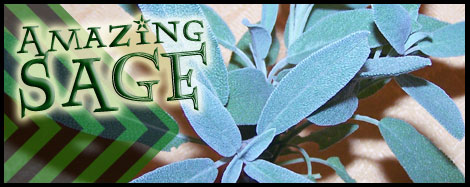
Well, we've always found the herb SAGE to be delightful in so many ways. That's why we've grown it here and elsewhere for years. Such a lovely, fragrant, sturdy, resilient herb, it's truly one of the easiest plants to communicate with -- and YES!, it truly IS a meaningful dialogue when you step out into the garden and sit among a patch of sage. All you need to do is listen carefully, and sage will speak its sage herbal wisdom to you.
I was wondering how sage came to be known as "sage" -- when all of the sources I had handy simply listed its technical name, salvia, along with its common name. Enter the great Wiki for an answer:
The name [Salvia] is derived from the Latin salvere("to save"), referring to the long-believed healing properties of salvia. The Latin was corrupted to 'sauja', to the French 'sauge', and to the old English 'sawge', and eventually became the modern day 'sage'.
I did not know that. Thank you, great Wiki! However, before we buy into that 100%, let's head over to reference.com where I think there's yet another interesting possibility. There, if you look at the origin of the word "sage," you'll see that it reportedly arrived in our tongue around the year 1250, ultimately via the Latin word sapidus, which means to be wise or to have "taste." This word was equivalent to sapere, which means to know or be wise and, quite interestingly, to taste -- as in literally to taste something.
Aside from whether or not Salvia morphed into "sage," I do find the connection between wisdom and taste absolutely fascinating. Don't you agree? I feel that it kind of speaks to our ancient, more primal methodologies for knowledge gathering. In ages past, we didn't seem to have that all-encompassing fear drilled into us from day one (regarding germs, etc.).
I believe there are actually few plants in the natural world that will actually kill a human being if ingested. (I think I heard Victoria Boutenko say once that there are really only 30 or so poisonous ones lurking about in our part of the world.) Many others will make you sick, of course. But, it's easily imaginable that, back before the time of printed books, certainly prior to the digital information age, information gathering activities likely included tasting things.
I don't think I have it in me to approach a plant I'm unfamiliar with and actually taste it, just out of curiosity. But, I imagine that we humans did, at some point -- and we in fact gained wisdom via our trials, passing that wisdom down through the ages via shamans and of course the oral tradition among healers. Here's a great quote on this, in which Stephen Buhner writes of the fear we now have of being in touch with plants:
If we eat the wild, it begins to work inside us, altering us, changing us. Soon, if we eat too much, we will no longer fit the suit that has been made for us. Our hair will begin to grow long and ragged. Our gait and how we hold our body will change. A wild light begins to gleam in our eyes. Our words start to sound strange, nonlinear, emotional. Unpractical. Poetic. ~Stephen Bunher, The Secret Teachings of Plants
Anyway, since we're so deep into history, let's fast-forward a little bit now, perhaps into the 1600s with the aforementioned (yesterday) Nicholas Culpeper.Here's a lovely little passage from the 17th century herbologist on the subject of sage:
Sage taken with wormwood is good for the bloody-flux. Pliny saith, it procures women's courses, and stays them coming down too fast; helps the stinging and biting of serpents, and kills the worms that breed in the ear, and in sores. ~The Complete Herbal
The 17th Century was so ... gross! Wasn't it !
 As I said in yesterday's post, you can't *always* follow the advice of an herbalist from the 1600s. However, in this case (as in many, many others), it seems Culpeper's description is spot-on. Pretty much all modern sources cite sage's healing properties as well. (I checked a ton of them for this post!)
As I said in yesterday's post, you can't *always* follow the advice of an herbalist from the 1600s. However, in this case (as in many, many others), it seems Culpeper's description is spot-on. Pretty much all modern sources cite sage's healing properties as well. (I checked a ton of them for this post!)
Sage is not only great for "sores," but is reputed to help with infections, inflammation issues (arthritis / rheumatism), sprains, respiratory issues, digestion, and much more. It's really one of those things that, no matter what's wrong with you, you can probably Google "sage" along with [fill in your health concern], and see what comes up.
If you're into the metaphysical side of herbs, you'll no-doubt be familiar with sage's many uses there. It's often used, for example, in cleansing and purification ceremonies -- a.k.a.smudging.To do this, just gather a bundle of sage, dry it, and then light one end briefly until it begins to smoke. From there, you would "smudge" your subject, be it a room, a person, or whatever you want to purify. (You may want to use a bit of discretion if smudging in a public place as the smoke tends to smell somewhat suspect, if you catch my drift.) Sage is also used metaphysically for longevity, for protection, to make wishes come true, for gaining wisdom, and even for gaining wealth.
Finally, in honor of today's post, I whipped up our own awesome raw soup recipe for dinner last night (see pic below!). The recipe is entitled, appropriately enough, "The Herbalist's Cauldron of Flavor," (see p. 26 in our free eBook, Raw Food Recipes).The recipe serves four and features a quarter cup of fresh sage leaves. There's still time to harvest a bit, so get out there and make this soup before it's too late! (If you don't have our free eBooks, just sign up here!)

